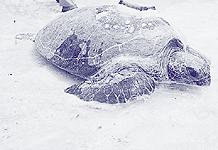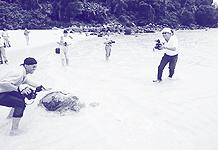|
Turtles of Sarawak and their
struggle against poachers
By
Catharine Goh

The green turtle is an endangered species in Sarawak. Photos:
Catharine Goh
|

A sea-bound turtle is at the centre of attention.
|
Sarawak may be well-known as the land of the hornbill or a sanctuary for
the orang utan but it is also home to five species of marine turtles namely the green
turtle, hawksbill turtle, olive ridley turtle, loggerhead turtle and leatherback turtle.
Their major nesting areas are on the Sarawak Turtle Islands of Pulau
Talang-Talang Besar, Pulau Talang-Talang Kecil and Pulau Satang Besar at Tanjung Datu
National Park.
These turtles also nest at Telok Melano, Samunsam Wildlife Santuary,
Similanjau National Park, Kampung Puguh and Tanjung Batu in Sematan as well as in Miri.
However the number of marine turtle nesting in Sarawak has declined by 90
per cent in the past 50 years.
According to the Sarawak Museum, which has conducted long-term conservation
and hatchery management since 1951, various reasons have contributed to the decline.
These factors included over-harvesting of eggs, incidental mortality in
fishing gear, hunting when the turtles swim into neighbouring countries, coastal
development, natural predation and various environmental causes.
The Sarawak Museum has also recorded the number of green turtles nesting
and landing on each of the three Turtle Islands since the mid-forties.
As part of the research and conservation efforts, the Sarawak Forest
Department started the rookery management in 1995 by opening the hatchery at Tanjung Datu
National Park.
Since 1996, the department has conducted extensive studies all year round
on its hatching success rate like tagging, hatchery management and nesting besides having
collaborative studies with Universiti Putra Malaysia in Terengganu, which is also famous
for its leatherbacks. Almost all nests have since been relocated to hatcheries for
incubation due to predators and poachers if left naturally.
The findings of the tagging and nesting study, for instance, is expected to
help monitor the activities of each individual nesting turtle and to estimate the
population size of Sarawak's marine turtles.
Another project is the Reef Balls Project, initiated to conserve marine
turtles in Sarawak as significant adult marine turtles have been found because of
trawlers' nets.
About 500 reef balls have been "seeded" around the marine turtle
nesting season resting areas.
Clusters of these reef balls, with a sharp, textured surface, have proven
very effective in damaging trawler nets.
Like all marine mammals such as dolphins and whales, all marine turtles are
totally protected animals under Section 29 (1) of the Wildlife Protection Ordinance, 1998.
Source: Borneo
Bulletin
BACK
TO LEISURE PAGE
|
